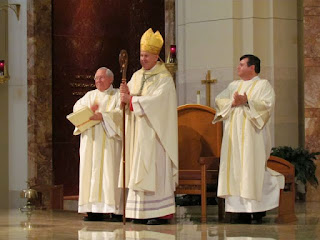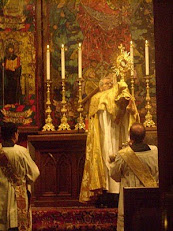
Fr. Jeffrey Steenson Processing into the Co-Cathedral of the Sacred Heart in Houston
at the Beginning of the Mass for his Institution as Ordinary of the Personal Ordinariate
of the Chair of St. Peter
The Chair of St. Peter and Christian Unity
“Behold how good and joyful a thing it is, for brethren to dwell together in unity!” (Ps. 133:1). With all our hearts, let us thank Pope Benedict XVI for this beautiful gift, the Personal Ordinariate of the Chair of St. Peter, and let us pray that it may further the goal of Catholic unity. When Cardinal Wuerl told me that the Holy Father would establish the Ordinariate under this name, I truly rejoiced, for it goes to the heart of what our mission should be. And it helps us to understand why our Lord entrusted His Church to St. Peter in the first place.
So much ink has been spilled over the interpretation of these words of our Gospel, which Jesus spoke to Peter in Caesarea Philippi – “You are Peter, and on this rock I will build my Church” (Mt. 16:18). Of course, for Catholics, the authoritative interpretation was provided at the First Vatican Council. But we must honestly acknowledge that Christians have read this text in different ways. Even amongst the church fathers there was not unanimity over what “On this Rock” means precisely. The great Augustine himself said that the reader must choose – Does this Rock signify Christ or Peter? (Retract. 1.20). But Augustine quite properly would not have thought this a matter of either/or. For Peter brings everything to Christ. The trajectory is clear. We are Christ’s and Christ is God’s (I Cor. 3:23). I am grateful that, over the course of my ministry, the teachings of Pope John Paul II and Pope Benedict XVI have been so clear on this point – the Church exists to bring souls to Christ. But, as our text plainly affirms, Jesus has invested Peter with a ministry of fundamental importance. And he does so by employing three verbs in the future tense – I will build my church … the gates of hell will not prevail against it … I will give you the keys of the kingdom of heaven. When Jesus speaks in the future tense, he draws all things to himself; we know then that this commission does not end with the historical Peter. The whole life of the Church on earth until the end of time is anticipated in this moment.
In this context, listen to St. Anselm, the 37th Archbishop of Canterbury, perhaps the greatest theologian ever to grace England’s green and pleasant land: “This power was committed specially to Peter, that we might therefore be invited to unity. Christ therefore appointed him the head of the Apostles, that the Church might have one principal Vicar of Christ, to whom the different members of the Church should have recourse, if ever they should have dissentions among them. But if there were many heads in the Church, the bond of unity would be broken” (Cat. Aur. Mt. 16:19).
The first time we find Matthew 16:18 specifically applied to Peter’s successors, the Bishops of Rome, came amidst a controversy between Pope Stephen and Cyprian of Carthage in the middle of the third century. At the risk of sounding pedantic, I hope that you will permit me to speak briefly to this, because it is very relevant to the Ordinariate. In the Anglican tradition, the church fathers are held in high esteem; here is where we were taught to find our bearings on theological questions.
The third century popes are heroes to me, because they were courageous pastors who sought to restore those brethren who had broken or fallen away to the full communion of the Catholic Church. At a time when many bishops were very severe and uncompromising about the purity of the Church, God gave us popes who understood that welcoming back the wandering and the fallen is of the very essence of the ministry that Jesus gave to the Apostles. In the letters of St. Cyprian there is a remarkable and revealing correspondence from St. Firmilian of Caesarea about Pope Stephen (Ep. 75, ca. 255) – Can you believe it, Cyprian? Stephen actually thinks that he sits on the chair of Peter as he orders us to accept the baptism of these separated groups! He actually wants us to regard these people as Christians!
I think this is the important context in which to understand what Pope Benedict is saying to us in Anglicanorum coetibus. Some will argue that the Catholic Church makes Christian unity a difficult thing to achieve. Look at what is being asked of those who are considering the Ordinariate! – Anglicans have not only to be received but even confirmed, and their clergy ordained in the absolute form. Is this not asking them to begin all over again? Certainly not! From Zephyrinus to Callistus to Cornelius to Stephen – these third century popes, most of whom laid down their lives as martyrs, who governed the Church at a time when it seemed as though the gates of hell really might prevail, threatening to destroy her essential unity – the Catholic Church simply asked that the bonds of charity be restored sacramentally by invoking the presence of the Holy Spirit. These are brothers and sisters, returning home.
The first principle of the Ordinariate is then about Christian unity. St. Basil the Great, the Church’s greatest ecumenist, literally expended his life on the work of building bridges between orthodox brethren who shared a common faith, but who had become separated from one another in a Church badly fragmented by heresy and controversy. He taught that the work of Christian unity requires deliberate and ceaseless effort. Like an old coat which is always being torn and is difficult to mend, the unity of the Church must never be taken for granted but requires great diligence and courage from her leaders (Bas. Ep.113). St. Basil often talked with yearning about the archaia agape, the ancient love of the apostolic community, so rarely seen in the Church of his day. This love, he taught, is a visible sign that the Holy Spirit is indeed present and active, and it is absolutely essential for the health of the Church. I can’t think of a better illustration for this homily than Bernini’s great sculpture of the Chair of St. Peter in the apse of St. Peter’s Basilica: Peter’s chair is upheld by the great fathers of the Church; and, hovering over it all, the luminous alabaster dove, the Holy Spirit, bathing everything in the radiance of God’s love.
There is so much to be celebrated about the patrimony of Anglicanism, its liturgical, spiritual, and pastoral traditions, which the Catholic Church welcomes as a treasure to be shared. But let us be clear about our first principles. So many people during the 477 years that Anglicans have been separated from Rome have prayed fervently and made great sacrifices for this day to come. In obedience and trust they embraced whole-heartedly all that Jesus’ prayer for the unity of his disciples requires (Jn. 17:21). It is surely no coincidence that this reconciliation should come at the very time Pope Benedict has put the new evangelization at the top of the Church’s agenda. To be converted and conformed to the image of Christ means that his Church will be transformed and renewed through and through. I so much appreciate how our Chancellor, Dr. Margaret Chalmers, puts it: “Our patrimony is people.” We thus open our hearts, in humility and love, to all Christians divided by culture and circumstance and misunderstanding. We extend our hand in friendship to all who seek the Truth. These are our companions along the way. We begin with a strong faith that God has given us Peter, his hand firmly on the tiller, returning us to Jesus, “the Shepherd and Bishop of our souls” (I Pet. 2:25).
– Fr. Jeffrey Steenson

Fr. Jeffrey Steenson greets lay and clerical representatives of the
Anglican Use parishes and Ordinariate after the decree of his
nomination by the Holy Father was read out by Donald Cardinal Wuerl
of Washington, D.C.



 Traditional Anglican Communion (TAC) Bishop David Moyer has been denied ordination into the Roman Catholic Church by Msgr. Jeffrey Steenson, the Ordinary of the Personal Ordinariate of the Chair of St. Peter. Citing a number of unresolved issues, he informed Moyer of his decision when he addressed the congregation of the Blessed John Henry Newman parish of Bishop Moyer last Sunday.
Traditional Anglican Communion (TAC) Bishop David Moyer has been denied ordination into the Roman Catholic Church by Msgr. Jeffrey Steenson, the Ordinary of the Personal Ordinariate of the Chair of St. Peter. Citing a number of unresolved issues, he informed Moyer of his decision when he addressed the congregation of the Blessed John Henry Newman parish of Bishop Moyer last Sunday.


























